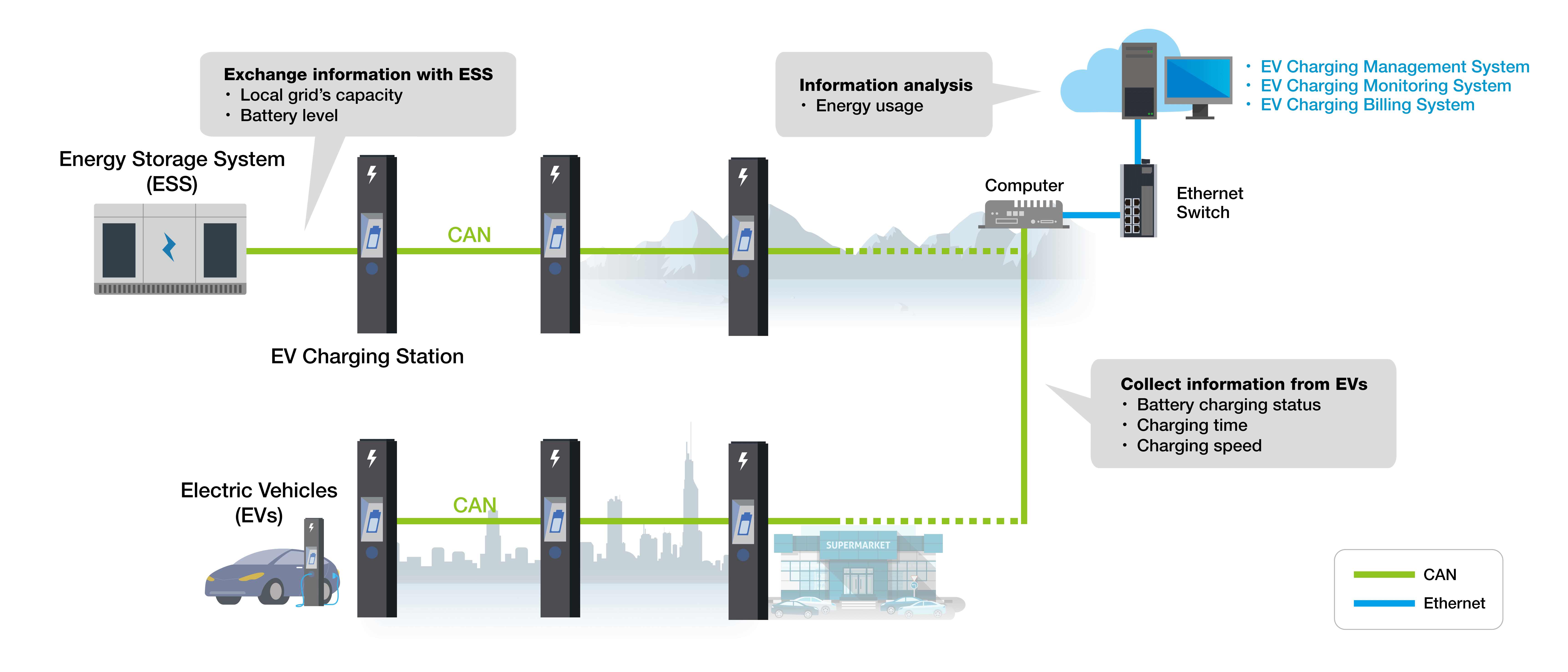An EV charging station, or electric vehicle supply equipment (EVSE), is an electrical device that recharges the batteries of electric vehicles (EVs). As more EVs hit the road, increasing EV charging stations will be crucial. We usually come across two types of EV charging stations: standalone and networked charging stations. Standalone EV charging stations operate without a network connection; networked charging stations connect to a charging network. Between the two, networked charging stations offer more benefits. Connecting multiple EV charging stations helps you build an EV charging system that enables operators to manage energy usage easily and remotely through application platforms. EV charging systems easily collect information, such as charging status and energy usage, from each EV and provide billing information to EV owners, based on when and how much power supply their EVs were charged with. In addition, EV charging systems also exchange information with the grid and an energy storage system (ESS) to improve the stability and reliability of power supplies from the ESS to EV charging stations. For example, when sudden demand peaks on the grid, EV charging systems inform the ESS, which allows them to use the energy stored in energy storage batteries.
To reap the benefits and get the most out of your EV charging systems, you must develop reliable communication between EV charging stations. In this article, we will discuss the communication challenges regarding the deployment of EV charging systems and offer solutions to enable reliable communication.
Communication Challenges for EV Charging Systems
EV charging systems rely on smooth and reliable communication to collect information for optimized EV charging efficiency. When EVs are plugged in at an EV charging station, the EV charging station, the grid, and the ESS exchange information such as battery charging status, the electricity capacity, and the energy usage through a wireless or wired network. The information is also sent to the control center for analysis, helping operators draw insights on exactly how much power wattage is required at a certain time. Therefore, sufficient power is always supplied to fulfill charging requirements.

A prerequisite for reliable communication is knowing how to enable connectivity for your EV charging systems. Operators face two commonly seen communication challenges when enabling reliable connectivity for their EV charging systems.
Transmission Limitation of CAN Communication Protocols
Automotives have adopted CAN bus as its communication bus; their internal batteries also use CAN bus. As many EVs and EV charging stations are communicating through CAN, your EV charging systems must be able to connect CAN devices used in EV charging stations. However, baudrates limit the transmission distance of a CAN system, as stated in the ISO 11898 standard. The faster the baudrate, the shorter the maximum transmission distance. In other words, the maximum transmission length of a CAN system for a given baudrate cannot be extended. To overcome this limitation regarding distance and deploy your EV charging stations with more flexibility, you need a networking solution that can address this issue to deliver the expected baudrates over long communication distances.
Find the Suitable Communication Interfaces
Some EV charging stations run by the same operators might be far from each other, making it difficult to connect them. For example, EV charging stations can be separately deployed between buildings or in suburbs, requiring a networking solution that can achieve long-distance connections. Some EV charging stations adopt wireless connectivity to share or transmit battery/electricity data among each other, lowering wiring deployment costs. However, many EV charger manufacturers and system integrators often experience wireless signal coverage below expectations or signal loss because of environmental limitations. Therefore, they prefer wired data connections for increased reliability and a better user experience. To establish reliable wired connections, fiber optic cables, instead of copper wires, are adopted to provide isolation and protection against electromagnetic interferences, and to transmit over long distances.
Reliable CAN-to-fiber Solutions
Our ICF-1171I CAN-to-fiber converters help you develop reliable communication for your EV charging systems because they break the limit of CAN bus communication and transmit up to 1 Mbps in CAN interfaces and up to 5 Mbps in CAN FD interfaces, extending your communication distance up to 40 km. As your networking devices are usually deployed inside space-limited cabinets in outdoor environments, our compact CAN-to-fiber converters come with 2 kV isolation and 2 kV surge protection for CAN port and -40 to 75°C wide temperatures to help you overcome harsh communication environments.
Connecting many EV charging stations to your control center usually takes multiple CAN-to-fiber converters to achieve long-distance communication. To make multiple device configurations easier, our CAN-to-fiber converters provide a DIP switch to switch interfaces between CAN and CAN FD easily. In addition, our CAN-to-fiber converters come with an auto baudrate setting function for the CAN interface so that you don’t need to perform any configurations. When a communication error occurs, you can check our LED indicators to quickly identify whether the error occurred in the CAN or fiber connection.
As an industry-leading connectivity solution provider, we provide a 5-year warranty for our CAN-to-fiber converters to ensure our product quality can meet your demands. Visit our product page for more information. If you are looking for other solutions to enable serial connectivity, we are committed to continuously developing a variety of serial connectivity solutions that help our customers enable connectivity for serial devices in the next decades. Visit our microsite to learn more.